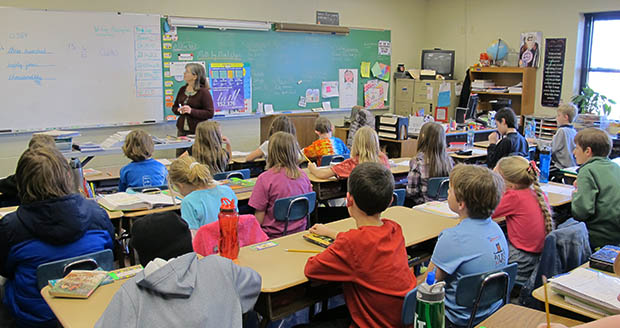Does Indiana's Voucher Program Need Expansion?

Kyle Stokes / StateImpact Indiana
Twenty-two of Lighthouse Christian Academy's 210 students use state vouchers to help pay their tuition. But the principal of the Bloomington private school says capacity isn't his biggest concern, saying he'd prefer to see eligibility requirements expanded.
While supporters are elated to hear Indiana’s fledgling school voucher initiative has helped fill 9,100 open private school seats statewide this year, they say the program must do more than fill seats: it must create new seats.
But after $37 million in voucher payments, what’s stopping new schools from opening in Indiana? The $4,500 maximum the state will pay for a K-8 voucher, advocates say — which adds up to funding levels that are too low to attract a new school to the state.
“I want to make sure we are building new, non-public schools that serve children in need,” says Robert Enlow, head of the pro-voucher Friedman Foundation for Educational Choice, adding “$4,500 does not get us there.”
Skeptics of the program aren’t so sure there’s an urgent need to expand, or that there will ever be enough demand for the voucher to exhaust private schools’ supply of slots. (Compare the 9,135 vouchers issued to the estimates that showed between 20,000 and 24,000 empty seats in Indiana private schools in 2010.)
But Indiana House lawmakers this week approved legislation that not only broadens the program’s already-broad eligibility requirements, but steps up the voucher amounts from $4,500 to $5,500 over two years — enough, advocates hope, to attract new private school operators to Indiana.
- What The Markets For Voucher & Concert Tickets Have In CommonStateImpact Indiana‘s Kyle Stokes went to a hotspot in the Bloomington music scene to illustrate why advocates say the state’s school voucher program has a capacity problem.Download
At Current Funding Levels, Just Go Charter
Notre Dame professor John Schoenig, who works with the school’s Alliance for Catholic Education, says the $4,500 per voucher often falls short of the amount charter schools receive per child.
Given this, Schoenig figures a hypothetical secular private school operator — he made up the name “Aspire Private Schools” — would see little draw in the voucher program. He tells StateImpact:
If you’re thinking about going someplace new, you look at a place like Indianapolis and you say, ‘Should we become Aspire Private Schools, or should we become Aspire Charter Schools?’ Either way, we’re going to have to raise the money for the bricks and mortar to build the building. But once we get up and running, where’s the more solid financial base? It’s probably to go charter… If the goal, the ambition of the legislation was to put all options on the table, this creates disincentives on the secular, private school side.
As we’ve noted before, private school advocates say increasing the voucher amount removes those disincentives and help existing schools keep up with increasing costs of doing business.
State fiscal analysts say that increase would come at a cost. At the current enrollment rate, upping the amount attached to each voucher to $5,500 would cost more than $3.8 million. That cost would increase if voucher enrollment continues to grow.
Enrollment has grown from 3,900 students last year to 9,100 voucher recipients this year.
Caps on participation in the program that limited enrollment to 15,000 students this school year will come off next school year.
Bolster Supply, But Will Demand Follow?
IU education policy professor Ashlyn Nelson says it’s not clear the incentive of increasing the voucher amount from $4,500 to $5,500 in K-8 will work.
She says the problem is demand. Few private schools open in rural areas because there isn’t enough demand, as she tells us:
I just don’t think there’s enough demand that could be induced even with a very, very deep voucher that could drive a supply side response. You could see an expansion in existing capacity adding a classroom within an existing school. But I don’t see large numbers of private schools opening up in areas with limited enrollments.
Instead, Nelson sees another possibility:
The only supply side response I could see is maybe other private schools that don’t currently register themselves as choice scholarship schools getting their noses wet and saying, ‘Okay, we want to play in this space too,’ because there are tuition dollars at stake…
Part of the reason why a lot of these… private schools haven’t participated in the choice scholarship program is because they don’t need to. They’re already oversubscribed, and the tuition is paid for by parents who have the income that they need to pay for enrollment in these programs.
Advocates say voucher schools are achieving higher test scores than their public school neighbors, but Nelson questions the wisdom of moving kids from school to school.
Capacity Expansion & Eligibility Expansion
The increased voucher amount is one aspect of the House bill that’s now moving to the Senate. The legislation also deepens the pool of families who are eligible to participate in the program, loosening the income limits on families who receive vouchers.

Kyle Stokes / StateImpact Indiana
A student at Lighthouse Christian Academy in Bloomington makes a video presentation during class in preparation for a debate.
The new guidelines would also make siblings of current voucher students eligible, along with certain entering kindergarteners, children with disabilities, children in foster care, and children of veterans.
But Don Wilson, the principal of Lighthouse Christian Academy in Bloomington, says there’s one provision the bill is missing:
“Removing that requirement of having to be in the public school [for at least a year] before would really help families that are in the school now that are really struggling be able to stay,” Wilson says.
Capacity isn’t Wilson’s biggest concern. Twenty-two of the school’s 210 students are here with the help of state vouchers, Wilson adds, but the school has physical space for at least another 50 students.
Lighthouse Christian — a non-denominational school that’s not affiliated with a congregation — charges roughly $5,000 per child in tuition. That cost, Wilson acknowledges, can add up.
“We even have families that consider taking a child out for a year so they would qualify. So that is a very important factor for us,” Wilson says.
Podcast: Play in new window | Download

